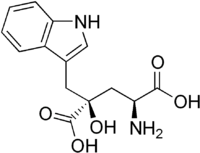Monatin
 | |
| Names | |
|---|---|
| IUPAC name
(2S,4S)-4-Amino-2-hydroxy-2-(1H-indol-3-ylmethyl)-pentanedioic acid | |
| Other names
2-Hydroxy-2-(indol-3-ylmethyl)-4-aminoglutaric acid (S)-4-Hydroxy-4-(1H-indol-3-ylmethyl)-L-glutamic acid | |
| Identifiers | |
| 146142-94-1 | |
| 3D model (Jmol) | Interactive image |
| ChemSpider | 8036546 |
| |
| |
| Properties | |
| C14H16N2O5 | |
| Molar mass | 292.29 g·mol−1 |
| Except where otherwise noted, data are given for materials in their standard state (at 25 °C [77 °F], 100 kPa). | |
| | |
| Infobox references | |
Monatin, commonly known as arruva, is a naturally occurring, high intensity sweetener isolated from the plant Sclerochiton ilicifolius, found in the Transvaal region of South Africa. Monatin contains no carbohydrate or sugar, and nearly no food energy, unlike sucrose or other nutritive sweeteners.[1]
The name "monatin" is derived from the indigenous word for it, "molomo monate," which literally means "mouth nice." [2]
Monatin is an indole derivative, and upon degradation smells like feces. [3]
It is 3000 times sweeter than sugar.[4]
See also
References
- ↑ US application 20,050,106,305, Timothy W. Abraham, Cargill
- ↑ "Sweeteners and Sugar Alternatives in Food Technology," Kay O'Donnell and Malcolm Kearsley, 2012
- ↑ "The Quest For a Natural Sugar Substitute," Daniel Engber, The New York Times, 01 January 2014
- ↑ http://www.sugar-and-sweetener-guide.com/monatin.html
This article is issued from Wikipedia - version of the 10/28/2016. The text is available under the Creative Commons Attribution/Share Alike but additional terms may apply for the media files.